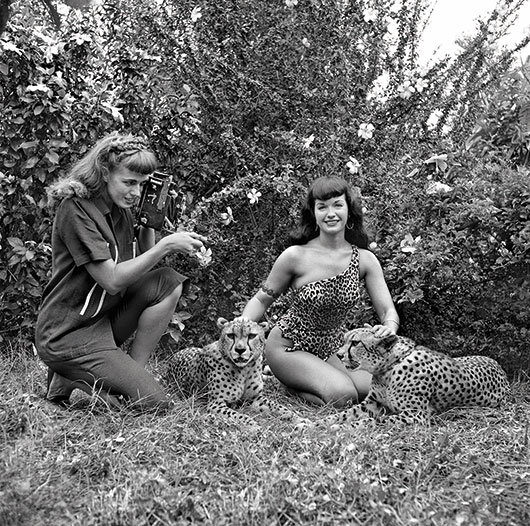How Bunny Yeager invented the pin-up
An interview with pin-up photographer Bunny Yeager, who has died aged 85
This article was first published in September 2012
You’ll know her work, if not her name. Bunny Yeager was the stills photographer for Ursula Andress during the filming of Dr No. The famous white bikini, shell in hand publicity shot came courtesy of Yeager’s camera. She took it while sharing a raft with the rest of the film crew, balanced over a muddy swamp, in an act of gung ho can-do-ism that was typical of her whole career.
When she wasn’t hobnobbing with stars, Yeager made a living shooting cheesecake portraits of comely, curvaceous women in and around her home in Florida. Pre-feminism – in fact twenty years before the first issue of seminal women’s weekly Ms was published, and the Female Eunuch just a twinkle in Germaine Greer’s pencil - Bunny Yeager was already making waves in a distinctly male arena.
In the early Fifties, magazines such as Rogue, Wink, Cad and Caper were powering a market for the type of pin-up shots that Yeager perfected. Her images, now collected together in Bunny Yeager’s Darkroom, became some of the most the most influential of the era, establishing a pert, burlesque style that would infiltrate fashion, music and film for years to come.
With her wide cheekbones, inked eyebrows, and long, shapely legs, Yeager had a special beauty of her own. Born Linnea Eleanor Yeager in a tiny steel town near Pittsburgh, she rechristened herself Bunny after a character played by Lana Turner in the 1945 Weekend at the Waldorf.
After high school in Florida she became hot property as a fashion model, but she had a problem: it was expensive to hand out pictures to prospective clients, and photographers charged extortionately for prints. Undefeated, she took herself to college to learn to make copies, discovering quite by chance that she was far more talented at wielding the camera than most of the men she had posed for.
A teacher encouraged her to send her work to a magazine, and after scouring the newsstands she chose a newcomer called Playboy. “Nobody had heard of Hugh Hefner” she tells me. “But I figured because they were new they might pay attention to an amateur, and that’s what happened. Hugh offered me $100 (about $850 today). If I hadn’t have made that early connection when he was just starting out, maybe I wouldn’t have got such a big push, but immediately I became employable.”
The pictures in question showed the relatively unknown Bettie Page. Pictured decorating the Christmas tree in nothing but a red and white fur cap it was the first of a series of collaborations between the two women that would establish both of their careers, though the partnership remained a working one: “we didn’t have time to be friends. She liked me, and she liked to pose for me, but I could only afford to pay her for 90 minutes a time and we spent every minute shooting. She was very good at taking direction.”
In fact Yeager had an arsenal of tricks up her sleeve. Working alone “I wasn’t lazy… I knew how to make the most out of somebody just by touching up their make-up or fixing their hair a little a bit and guiding their pose, moves of the hand, whatever it took to get a good picture.”
Yeager had taught herself these tricks through hours of shooting herself in her own home, in the sorts of coquettish poses that were sure to enthral male readers. “I saw there was a rhythm to this thing, so I wrote a book [How I Photograph Myself] so that any girl could read it and become a good model. Even if she just wanted to take one beautiful picture of herself she could do it in the privacy of her home instead of going to a strange male photographer and being embarrassed taking off her clothes.”
The chief remit of her book is to emphasise that any women can look good with the right attention. “What a boring place the world would be if every woman looked the same as the next…Make the most what you have and enjoy being female; enjoy being YOU.”
These women have curves and even visible cellulite. “I don’t like the skinniness” she says of today’s ideal. “I like to see a model who has meat on her bones. For fashion, maybe you need to show off the clothes, but if you want to show off a beautiful woman, you need her to be shapely, to show that she is a woman.”
Now 83, she shows no signs of slowing. Last year she acted as Grand Marshal for a three day festival of marching bands and vintage cars along Miami’s Ocean Drive. She still photographs too – her last self-portrait was taken only last year – and has just moved into a new studio near her home, where she continues to write books. This is her 32nd.
Of the rarity of her success in a male-dominated arena she is reticent. “I didn’t know anybody else who was doing it, sure, but I wasn’t paying attention to what other people were doing, I just got involved in my work and it took me from one step to another. I was just confident my work was good.”
'Bunny Yeager’s Darkroom’ by Petra Mason (Rizzoli, £37.50, published Sep 25) is available to order from Telegraph Books at £33.50+£1.35p&p. 0844 871 1516; books.telegraph.co.uk









